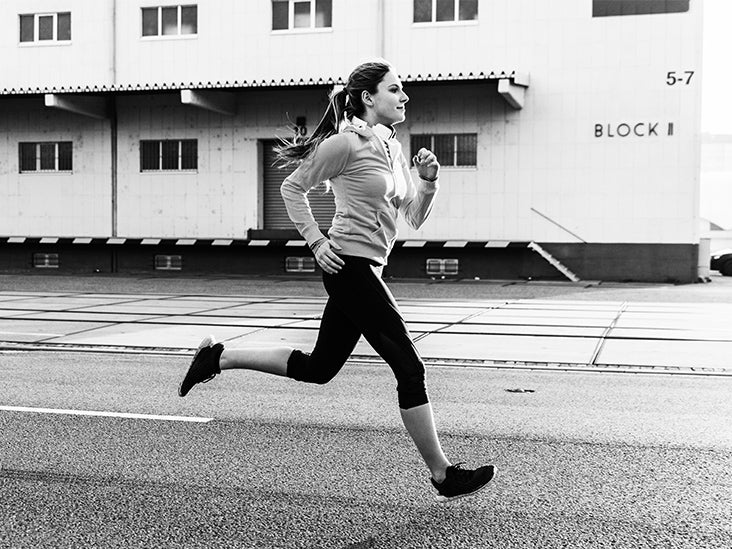- Researchers from Amsterdam conducted a study to see whether running is as useful as antidepressants in treating symptoms of depression and anxiety.
- The researchers found that both groups had similar improvements in depressive symptoms.
- However, the running group also saw improvements in physical health, while participants taking antidepressants had slightly poorer physical health.
Many people with depression, sometimes situational or mild, may not need treatment. However, others experience more severe levels of depression.
In the case of people with clinical depression, treatments including psychotherapy and/or specific medications may be appropriate.
According to the National Alliance on Mental Illness, 8.3% of adults in the United States experience an episode of major depression each year. Besides,
Because depression is so common, scientists are interested in improving treatments. Researchers in Amsterdam wondered whether jogging could have the same benefits as taking antidepressants.
To do this, researchers recruited more than 100 participants in a study comparing the effects of running and antidepressants in improving symptoms of depression and anxiety. Each group followed a 16-week regimen of participating in running therapy or taking antidepressants.
After 16 weeks, researchers found that both groups had similar improvements in symptoms.
These findings were presented at the ECNP Congress in Barcelona, Spain and appear in Journal of affective disorders.
Researchers recruited 141 participants with depression or anxiety disorders. They gave participants the option of taking the SSRI antidepressants escitalopram or sertraline or participating in a running group two to three times per week.
Participants must agree to provide a blood sample, undergo a psychiatric evaluation, and complete a self-assessment to assess their mental state. The average age of the participants was 38.2 years, and 58.2% of the group were female.
Most participants chose to run, and if a participant had no preference, the researchers assigned them to a group. Overall, the running therapy group had 96 participants and the antidepressant group had 45 participants.
Running group participants are required to participate in two or three 45-minute running sessions per week. Researchers expected them to complete at least 70% of the sessions, and participants wore heart rate monitors during running sessions so researchers could track their participation levels and other data. .
Researchers prescribed escitalopram (Lexapro) for the class of antidepressants, but if they found the drug was not effective or participants did not tolerate it well, they switched to sertraline (Zoloft).
Depression and anxiety are both common mental health problems in the United States. In addition to the impact these problems have on some people’s mental health, they can affect physical health.
Some physical health problems associated with depression include:
- chronic joint pain
- sleep disorders
- Gastrointestinal problems
- changes in psychomotor activity.
Besides,
The effects on both mental and physical health make it extremely important to treat ongoing depression. Many doctors prescribe medications from the antidepressant class such as selective serotonin reuptake inhibitors (SSRIs), serotonin and norepinephrine reuptake inhibitors (SNRIs), and tricyclic antidepressants.
However, treating depression with medication is not the only option. Increased physical activity may be beneficial by increasing endorphins, a chemical the body produces that improves mood.
Given both the pharmacological treatment of depression and the fact that physical activity boosts endorphins, the researchers in the current study wondered whether jogging therapy could be as beneficial as antidepressant use. depression or not.
While most participants chose running therapy, adherence to the treatment plan was overall lower among this group. Among the participants, 82.2% of those in the antidepressant group adhered to their medication regimen, while only 52.1% of those in the running therapy group completed their exercise sessions. Minimum required.
Regardless of which treatment plan people participated in, both groups saw improvements in their overall mental health.
When comparing the participants’ depressive symptoms at the beginning of the study to the end, 43.3% of the running treatment group saw their depression improve and 44.8% of the medication group. antidepressants have gone into remission.
Participants in the antidepressant group saw improvements in their anxiety symptoms faster than those in the running group, but the final results at the end of the 16-week study were nearly the same.
Although both treatment plans were nearly identical in terms of improvement in depression, the running therapy group saw improvements in physical health that the antidepressant group did not.
Participants in the running group lost weight, improved lung function, lowered blood pressure and lowered heart rate. The group taking antidepressants experienced weight gain and increased blood pressure.
This study demonstrates the importance of exercise for people with depression and anxiety as well as caution when using antidepressants in physically unhealthy patients, the authors write. .
Dr. David Merrill, a geriatric psychiatrist and director of the Pacific Brain Health Center of the Pacific Neuroscience Institute in Santa Monica, California, who was not involved in the current study, spoke with Medical news today About the study.
This is an important study, Dr. Merrill began before explaining how antidepressants and running can impact the brain.
Both antidepressants and running increase brain-derived neurotrophic factor (BDNF) in the brain. BDNF is an important neuroplasticity-enhancing molecule that plays an important role in maintaining normal mood, he said.
Depressive states can reduce BDNF levels, which can be corrected with medication or exercise. Ideally, Dr. Merrill says, patients can try the combination for a synergistic effect.
Brain-Derived Neurotrophic Factor (BDNF) is like Miracle Grow for the brain; That’s one reason why regular physical activity is important for brain health.
Dr. David Merrill
When Dr. Merrill explained the study results in detail, he said he wished more people would stick to the exercise routine.
It’s disappointing to see how many people quit exercising. It would be nice to see why future interventions could be modified to increase the likelihood of successfully starting and maintaining a mood-boosting exercise regimen, he said.
There is no one-size-fits-all approach to treating depression
Dr. Ryan Sultan, a board-certified psychiatrist, therapist, and professor at Columbia University in New York City, who was also not involved in the study, spoke to MNT about the findings .
The topic of treating depression is always at the forefront of psychiatric discussions, he said, and this new study offers compelling insights into the comparative effects of running and antidepressants. depression in the treatment of this condition.
Although Dr. Sultan finds the research compelling, he notes that there is no one-size-fits-all approach to treating depression.
Although both running and antidepressants appear to be effective in treating depression, it is essential to understand that each individual’s needs and responses may vary. It is important to consult with a medical professional before making decisions about treatment options.
Dr. Ryan Sultan
#Depression #running #effective #antidepressants
Image Source : www.medicalnewstoday.com

